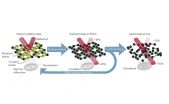INFORMATION:
Controlling phase changes in solids
A recent study demonstrates the rapid control of phase-changes in resonantly bonded materials
2015-07-28
(Press-News.org) Rewritable CDs, DVDs and Blu-Ray discs owe their existence to phase-change materials, those materials that change their internal order when heated and whose structures can be switched back and forth between their crystalline and amorphous phases. Phase-change materials have even more exciting applications on the horizon, but our limited ability to precisely control their phase changes is a hurdle to the development of new technology.
One of the most popular and useful phase-change materials is GST, which consists of germanium, antimony, and tellurium. This material is particularly useful because it alternates between its crystalline and amorphous phases more quickly than any other material yet studied. These phase changes result from changes in the bonds between atoms, which also modify the electronic and optical properties of GST as well as its lattice structure. Specifically, resonant bonds, in which electrons participate in several neighboring bonds, influence the material's electro-optical properties, while covalent bonds, in which electrons are shared between two atoms, influence its lattice structure. Most techniques that use GST simultaneously change both the electro-optical and structural properties. This is actually a considerable drawback since in the process of repeating structural transitions, such as heating and cooling the material, the lifetime of any device based on this material is drastically reduced.
In a study recently published in Nature Materials, researchers from the ICFO groups led by Prof. Simon Wall and ICREA Prof. at ICFO Valerio Pruneri, in collaboration with the Firtz-Haber-Institut der Max-Planck-Gesellschaft, have demonstrated how the material and electro-optical properties of GST change over fractions of a trillionth of a second as the phase of the material changes. Laser light was successfully used to alter the bonds controlling the electro-optical properties without meaningfully altering the bonds controlling the lattice. This new configuration allowed the rapid, reversible changes in the electro-optical properties that are important in device applications without reducing the lifetime of the device by changing its lattice structure. Moreover, the change in the electro-optical properties of GST measured in this study is more than ten times greater than that previously achieved by silicon materials used for the same purpose. This finding suggests that GST may be a good substitute for these commonly used silicon materials.
The results of this study may be expected to have far-reaching implications for the development of new technologies, including flexible displays, logic circuits, optical circuits, and universal memory for data storage. These results also indicate the potential of GST for other applications requiring materials with large changes in optical properties that can be achieved rapidly and with high precision.
ELSE PRESS RELEASES FROM THIS DATE:
Use of cell-free microRNA as potential cancer biomarkers made possible through Droplet Digital™ PCR
2015-07-28
Hercules, CA -- July 28, 2015 -- Droplet Digital PCR (ddPCR™) has been shown to be a useful tool for the identification of microRNAs (miRNA) circulating in the blood that could serve as potential cancer biomarkers. A study in the journal Oncotarget further supports these findings and identifies a novel miRNA that shows great potential for breast cancer diagnosis. These findings confirm the potential clinical utility of ddPCR technology to precisely and reliably quantify cell-free miRNAs. The study also emphasizes that sample type as well as its preparation are critical ...
More secondary schools serve healthier lunches
2015-07-28
ANN ARBOR--Secondary students found healthier foods on more lunch menus in 2013 than in 2011, resulting in fewer nutrition disparities for small schools or those with racially diverse student bodies.
The findings by University of Michigan researchers show significant improvements made in the National School Lunch Program at public middle and high schools in 2013 after many years of meal disparities based on school size or demographics.
"While these improvements are encouraging, continued progress is needed," said Yvonne Terry-McElrath, a researcher at the U-M Institute ...
Chimpanzees binge on clay to detox and boost the minerals in their diet
2015-07-28
Wild chimpanzees in the forests of Uganda are increasingly eating clay to supplement the minerals in their diet, according to a long-term international study published in the early version of the journal PLOS ONE. The paper led by the University of Oxford describes how the researchers observed wild chimpanzees in the Budongo forest eating and drinking from clay pits and termite mounds. The paper concludes that this change in diet may be partly due to the widespread destruction of raffia palm trees that chimps relied on for their minerals in the past. However, the main reason ...
Autism costs estimated to reach nearly $500 billion, potentially $1 trillion, by 2025
2015-07-28
(SACRAMENTO, Calif.) -- UC Davis health economists have for the first time projected the total costs of caring for all people with autism spectrum disorder (ASD) in the U.S. for the current calendar year and in 10 years if effective interventions and preventive treatments for the condition are not identified and widely available.
Their forecasts for ASD-related medical, nonmedical and productivity losses are $268 billion for 2015 and $461 billion for 2025. The researchers noted that these estimates are conservative and, if ASD prevalence continues to increase as it has ...
Improvement in the quality of VMMC made possible through the continuous quality improvement approach
2015-07-28
The continuous quality improvement (CQI) approach was introduced on a pilot basis to 30 sites across Uganda. This approach identified barriers in achieving national standards for voluntary medical male circumcision (VMMC), identified possible solutions to overcome these barriers, and carried out improvement plans to test these changes while collecting performance data to objectively measure whether they had bridged gaps.
Teams used a 53-indicator quality assessment tool adapted by the Ministry of Health and based on the WHO VMMC Quality Toolkit as a management tool to ...
World's first bilateral hand transplant on child at Children's Hospital of Philadelphia
2015-07-28
Surgeons at The Children's Hospital of Philadelphia (CHOP) joined with colleagues from Penn Medicine recently to complete the world's first bilateral hand transplant on a child. Earlier this month, the surgical team successfully transplanted donor hands and forearms onto eight-year-old Zion Harvey who, several years earlier, had undergone amputation of his hands and feet and a kidney transplant following a serious infection.
Led by L. Scott Levin, M.D., FACS*, Chairman of the Department of Orthopaedic Surgery at Penn Medicine, Director of the Hand Transplantation Program ...
How to digitally stoke that old-time auction fever
2015-07-28
Whether online auctions are selling rare Pokemon cards or fine art, the science behind inciting the highest bids gets a boost from a paper to be published in the September issue of the Journal of Retailing. Researchers from Germany and Australia teamed up to explore how bidders' emotions are affected by different types of auctions and how those emotions affect their bidding.
In "Auction Fever! How Time Pressure and Social Competition Affect Bidders' Arousal and Bids in Retail Auctions," the three authors - Marc T.P. Adam of the University of Newcastle, Professor ...
Sleepy fruitflies get mellow
2015-07-28
PHILADELPHIA - Whether you're a human, a mouse, or even a fruitfly, losing sleep is a bad thing, leading to physiological effects and behavioral changes. One example that has been studied for many years is a link between sleep loss and aggression. But it can be difficult to distinguish sleep loss effects from stress responses, especially in rodent or human models.
A team of researchers from the Perelman School of Medicine at the University of Pennsylvania used fruitflies to probe deeper into the cellular and molecular mechanisms that govern aggression and sleep. They ...
Firms 'underinvest' in long-term cancer research
2015-07-28
Pharmaceutical firms "underinvest" in long-term research to develop new cancer-fighting drugs due to the greater time and cost required to conduct such research, according to a newly published study co-authored by MIT economists.
Specifically, drugs to treat late-stage cancers are less costly to develop than drugs for earlier-stage cancers, partly because the late-stage drugs extend people's lives for shorter durations of time. This means that the clinical trials for such drugs get wrapped up more quickly, too -- and provide drug manufacturers more time to control patented ...
Penn Vet study shows immune cells in the skin remember and defend against parasites
2015-07-28
Just as the brain forms memories of familiar faces, the immune system remembers pathogens it has encountered in the past. T cells with these memories circulate in the blood stream looking for sites of new infection.
Recently, however, researchers have shown that memory T cells specific to viral infections can also set up residence in particular tissues. There, they stand guard, ready to respond quickly to the first sign of reinfection.
Now, research led by a team from the University of Pennsylvania School of Veterinary Medicine shows that these resident memory T cells ...
LAST 30 PRESS RELEASES:
Home fingertip oxygen monitors less accurate for people with darker skin tones
Six weeks in a cast no less effective than surgery for unstable ankle fractures
Precautionary approach to alcohol-free and low alcohol drinks needed to protect public health, say experts
Gas-atomized Ca–Mg alloy powders produce hydrogen simply by adding water — high-efficiency hydrogen generation at room temperature
British redcoat’s lost memoir reveals harsh realities of life as a disabled veteran
World-leading rare earth magnet recycling facility launches in UK
Corday Selden selected for the Oceanography Society Early Career Award
MIT chemists determine the structure of the fuzzy coat that surrounds Tau proteins
Same moves, different terrain: How bacteria navigate complex environments without changing their playbook
Severe weather is deadly for vulnerable older adults long after the storm ends, study finds
Expert panel highlights opportunities for improving cancer studies
Hearing aid prescriptions not associated with changes in memory and thinking
Seth Zippel selected for The Oceanography Society Early Career Award
Jeremy Horowitz selected for The Oceanography Society Early Career Award
Kennesaw State University’s Jerry Mack named Paul “Bear” Bryant Newcomer Coach of the Year
Ancient teeth are treasure troves of data on Iron Age lifestyles
Avocados may become easier to grow in India—but not if global emissions remain high
Pregnant women with IBD show heightened inflammation in vaginal mucosa
Underwater photos show seabirds, seals and fish interacting with a tidal turbine in Washington State
1 in 5 surveyed UK adults who have experienced the death of a pet report it as more distressing than experienced human deaths, with significant rates of prolonged grief disorder symptoms also being re
Polyester microfibers in soil negatively impact the development of cherry tomato plants in experiments, raising concerns over the potential effect of high levels of such contaminants
LGBTQ+ adults may be around twice as likely to be unemployed or to report workforce non-participation compared to heterosexual adults, per large representative Australian survey
Horses can smell fear: In experiments where horses smelled sweat from scared humans, they reacted to scary and sudden events with increased fear and reduced human interaction
New synaptic formation in adolescence challenges conventional views of brain development
Scientists identify target to treat devastating brain disease
Oliver Zielinski selected as Fellow of The Oceanography Society
Has progress stalled on gender equality at work?
Quantum simulator sheds light on how nature moves energy in systems like photosynthesis and solar conversion
Can a hashtag help prevent atrocities? Study shows social media can be a powerful tool
The American Ornithological Society (AOS) announces the winner of the 2025 Wesley Lanyon Award
[Press-News.org] Controlling phase changes in solidsA recent study demonstrates the rapid control of phase-changes in resonantly bonded materials

